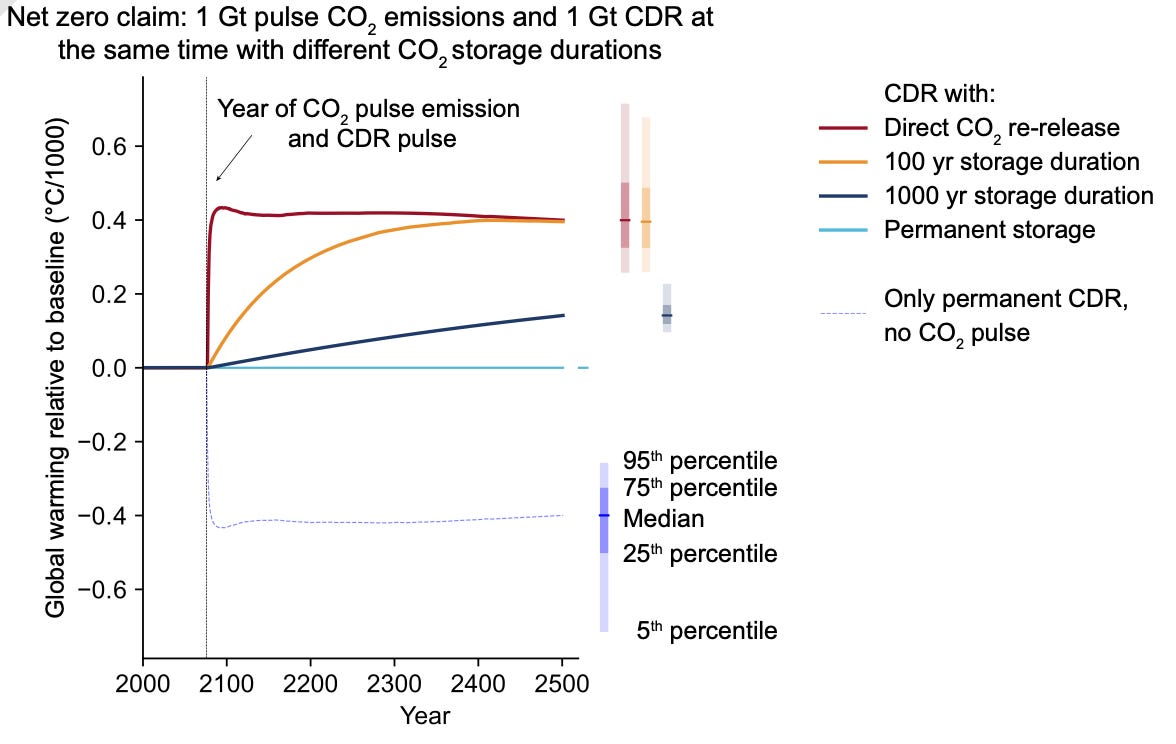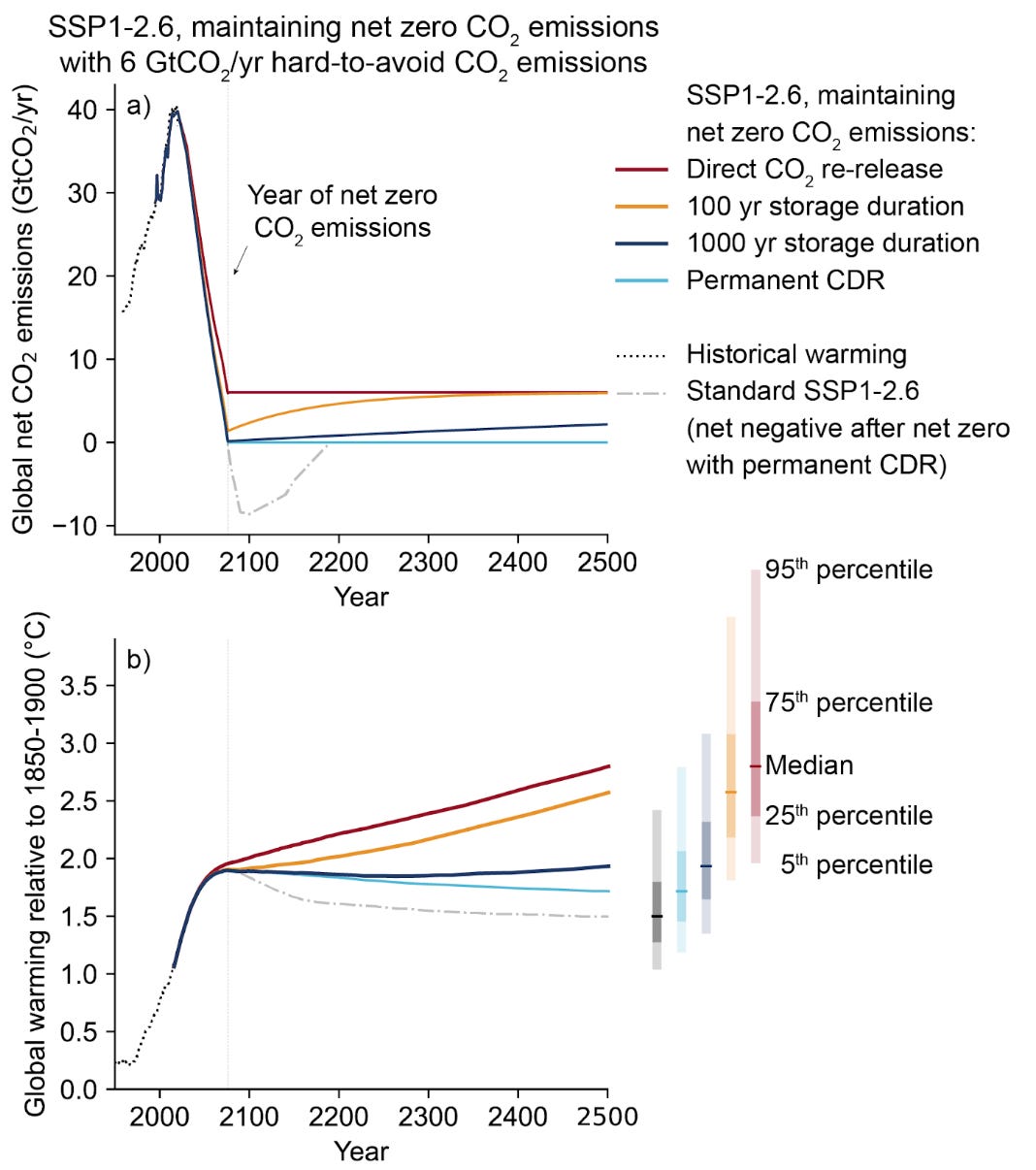Durability of carbon dioxide removal is critical for stabilizing temperatures
Posted on 20 November 2024 by Zeke Hausfather
This is a re-post from the Climate Brink
The world is emitting over 40 gigatons of CO2 per year, contributing to an accelerating warming of the planet. The world needs to cut emissions rapidly to be remotely on track to meet our Paris Agreement goals of limiting warming to well-below 2C, and we should be spending the vast majority (>95%) of our resources today on reducing emissions.
But once we get close to zero emissions, we will need to rely on an increasing amount of carbon dioxide removal (CDR) to stabilize temperatures. As I discussed in an earlier Climate Brink article, every ton of CO2 we put in the atmosphere continues to warm the earth for millennia to come. Getting to zero emissions will stop the Earth from warming, but will not cool the planet back down. The only way to do that, or to counterbalance any remaining positive emissions in the system, is to actively remove CO2 from the atmosphere.
However, because of the extremely long warming effects of our emissions today, I’ve long argued that only carbon dioxide removal that removes CO2 from the atmosphere for millennia – comparable to the atmospheric residence time of CO2 – can actually counterbalance our fossil fuel emissions.
Net-zero requires a “like for like” framework
I have a new paper out in the Nature journal Communications: Earth and Environment today titled “Durability of carbon dioxide removal is critical for Paris climate goals”. I teamed up with ETH Zurich researchers Cyril Brunner and Reto Knutti to run climate model simulations of differing carbon removal durability over the next 500 years.
Figure 1 from our paper, shown below, explores the climate impacts of 1 GtCO2 emissions and 1 GtCO2 removals deployed simultaneously. The red line shows what would happen to the climate if the captured CO2 was immediately re-released, while the orange, dark blue, and light blue lines show the impact of 100-year, 1000-year, and permanent carbon removal, respectively.1

Here we see that only permanent storage fully reverses the climate impact of a pulse of CO2 emissions over a 500-year timeframe. Notably, there is no significant cooling of the climate that occurs after the emissions pulse, suggesting that we cannot use temporary climate removal to buy time until the climate cools back down (similar to how geoengineering would not actually solve the problem).
This reinforces the finding (by many of the climate scientists behind the idea of net-zero emissions) in Allen et al 2022 that “durable, climate-neutral net zero strategies require like-for-like balancing of anthropogenic greenhouse gas sources and sinks in terms of both origin (biogenic versus geological) and gas lifetime” and that “the requirement that any continued generation of fossil CO2, whether or not it is emitted to the atmosphere, must be balanced by geological CO2 sequestration or equally permanent disposal.”
Breaking the Paris Agreement targets
CDR plays two different roles in our mitigation scenarios. First, it is used to deal with any overshoot of a temperature target, as only net-negative emissions can significantly cool the climate after the point of net-zero emissions.2 But it also plays an important role in dealing with some residual emissions in the economy that are to difficult or expensive to fully mitigate. Deep decarbonization scenarios typically deploy around 6 gigatons of CO2 (GtCO2) per year at the point of net-zero to deal with these residuals.
In our paper we explored the climate impacts of using differing durabilities of CDR to deal with these residual emissions. We deliberately chose not to explore overshoot scenarios to minimize the amount of CDR we were simulating.
The figure below shows both the emissions and climate response over time with 6 GtCO2 residual emissions under a SSP1-2.6 scenario (designed to limit warming to around 1.8C by 2500.

We find that using 100-year durability removals (which characterize many forestry and soil carbon projects today) to neutralize 6 GtCO2 per year residual emissions would result in approximately 0.8C warming by 2100, bringing temperatures up to around 2.6C by 2500 rather than stabilizing global temperatures well-below 2C.
That said, less durable solutions still have a role to play. Temporary removals such as afforestation/reforestation or soil carbon can counterbalance land use emissions, and have real value in minimizing peak temperatures.
But the science is clear: if we want to stabilize global temperatures, only permanent removals (>1,000 years) can credibly neutralize ongoing emissions from fossil fuels, and it is important that our net-zero systems reflect this physical reality.
1 In the paper we simulate different durabilities using an exponential decay function with a mean residence time 100 or 1000 years. However, the supplementary materials includes versions of all the figures where all CO2 is stored for exactly 100 or 1000 years before being instantly re-released.
2 To avoid angering David Keith, I should mention that geoengineering could also cool the climate. But that poses significant moral hazard risks and does not avoid the need for massive amounts of CDR if we ever want to stop.































 Arguments
Arguments






























Comments